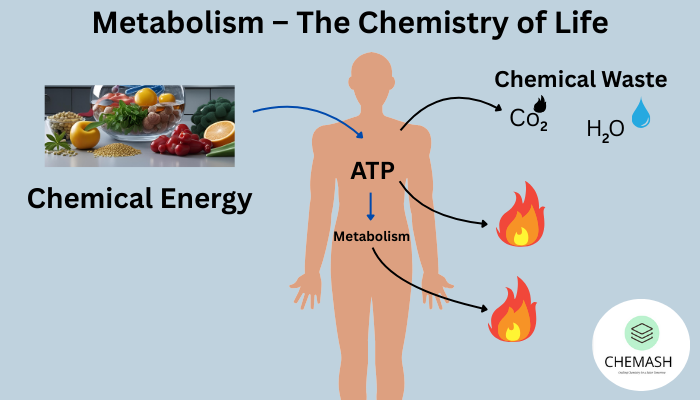Metabolism – The Chemistry of Life

Table of Contents
- What is Metabolism?
- Types of Metabolism
- Functions of Metabolism
- Key Metabolic Pathways
- Role of Enzymes
- Regulation of Metabolism
- Biological Importance
- FAQs on Metabolism
What is Metabolism?
Metabolism is the sum of all biochemical reactions that occur within a living organism to sustain life. These reactions enable cells to grow, reproduce, maintain structures, and respond to environments.
Keyword:Metabolism = Catabolism + Anabolism
Two Branches of Metabolism
- Catabolism – Breakdown of complex molecules into simpler ones, releasing energy (e.g., glycolysis, respiration).
- Anabolism – Synthesis of complex molecules from simpler ones, using energy (e.g., protein synthesis, DNA replication).
Main Functions of Metabolism
- Energy production and storage
- Building cellular structures
- Elimination of metabolic waste
- Synthesis of essential biomolecules
- Regulation of cellular responses
Key Metabolic Pathways
- Glycolysis – Breakdown of glucose into pyruvate with ATP production
- Krebs Cycle – Aerobic cycle generating NADH and FADH2
- Electron Transport Chain – Uses electrons to generate ATP
- Photosynthesis – Converts solar energy into glucose
- Gluconeogenesis – Formation of glucose from non-carbohydrate sources
- Lipolysis & Lipogenesis – Fat breakdown and synthesis
Role of Enzymes
Metabolic reactions are catalyzed by enzymes. They lower activation energy and ensure efficiency.
Example: Amylase breaks down starch into sugars.
Regulation of Metabolism
- Feedback inhibition
- Hormonal control (insulin, glucagon)
- Temperature & pH influence
Biological Importance
- Sustains life processes
- Determines energy balance
- Helps in diagnosis of disorders
- Essential for homeostasis
FAQs on Metabolism
1. What is metabolism in biology?
Metabolism is the chemical process that sustains life by breaking down and building molecules.
2. What are the two types of metabolism?
Catabolism and Anabolism.
3. What are examples of metabolic pathways?
Glycolysis, Krebs cycle, electron transport chain, and photosynthesis.
Multiple Choice Questions
- Which of the following is an anabolic process?
- a) Glycolysis
- b) Protein synthesis ✅
- c) Krebs cycle
- d) Fermentation
- The breakdown of glucose to release energy is called:
- a) Photosynthesis
- b) Respiration ✅
- c) Anabolism
- d) Nitrogen fixation
- Which organelle is known as the “powerhouse of the cell”?
- a) Nucleus
- b) Ribosome
- c) Mitochondria ✅
- d) Endoplasmic reticulum
True or False
- Catabolism is an energy-releasing process. → True ✅
- Anabolism breaks down large molecules into smaller ones. → False ❌ (It builds molecules)
- Mitochondria are responsible for ATP production in cells. → True ✅
Fill in the Blanks
- The sum total of all biochemical reactions in an organism is called ________. (Answer: Metabolism)
- The energy currency of the cell is ________. (Answer: ATP)
- The process of glucose breakdown in the cytoplasm is known as ________. (Answer: Glycolysis)
